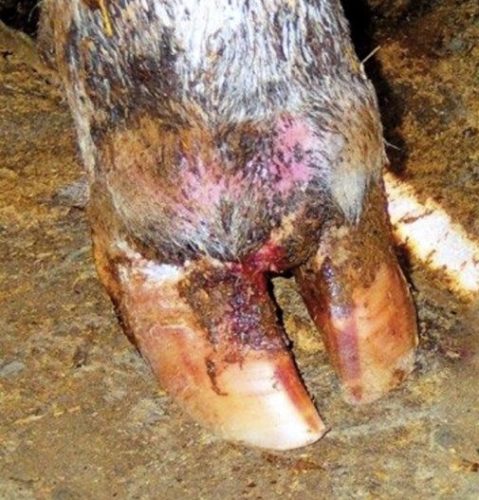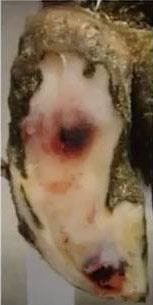Foot health and lameness in feedlot cattle
Posted: November 26, 2019 | Written By: Lisa Wuertz, Form-A-Feed Marketing Administrator

Foot health and lameness in feedlot cattle can have a significant impact on profitability and cattle performance. While much research has been done on lameness in the dairy industry, there has been less emphasis on the impact of foot health and lameness in feedlot cattle. Prevention, early diagnosis of the condition, and following the correct treatment protocol can help reduce the incidence of lameness and help prevent negative effects on feedlot performance.
Foot rot
 Foot rot is a disease of the soft tissue between the claws characterized by a foul smell and swelling between the toes. As it progresses, the toes can spread apart. Foot rot occurs when damage to the interdigital space allows Fusobacterium necrophorum to invade and infect the foot. This bacterium is profusely present in cattle yards. Wet, muddy lots or changes from freezing and thawing can compromise the interdigital skin condition, leaving an opportunity for bacteria to invade. Foot rot occurs more frequently in wet times of year, so maintaining clean, dry lots and regular removal of loose mud and manure can help prevent the prevalence. Watch for mud build-up along bunks and waterers as these can also be culprits.
Foot rot is a disease of the soft tissue between the claws characterized by a foul smell and swelling between the toes. As it progresses, the toes can spread apart. Foot rot occurs when damage to the interdigital space allows Fusobacterium necrophorum to invade and infect the foot. This bacterium is profusely present in cattle yards. Wet, muddy lots or changes from freezing and thawing can compromise the interdigital skin condition, leaving an opportunity for bacteria to invade. Foot rot occurs more frequently in wet times of year, so maintaining clean, dry lots and regular removal of loose mud and manure can help prevent the prevalence. Watch for mud build-up along bunks and waterers as these can also be culprits.
Some producers are finding success in preventing foot rot with the use of vaccines. Volar (Bayer) and Fusogard (ImmTech Biologics) are licensed vaccines that contain strains of F. necrophorum. Two doses of these vaccines must be administered for protection.
Treatment: If feasible, clean the foot and apply a topical treatment. Cattle with foot rot respond well to treatment with antimicrobials and anti-inflammatories. Several antibiotics are labeled for the treatment of foot rot, such as oxytetracycline, including Bio-Mycin® 200 or Liquamycin LA-200®, florfenicol, (Nuflor®) ceftiofur (Excede® or Excenel®) and tulathromycin (Draxxin®). Oxytetracycline is available over the counter. Others are available by prescription through your veterinarian. It is important to use these products exactly as directed on the label and with attention to Beef Quality Assurance guidelines.1 Cattle can often be treated and returned to their regular pen or lot unless the case is severe. Consult your veterinarian for the best treatment options for your operation.
Abscesses
 Abscesses start from an injury to the sole. This allows bacteria to enter below the hard surface of the sole, causing an infection of the inner tissue. Typically, there is minimal swelling at the onset, but it is very painful and cattle will quickly become lame.
Abscesses start from an injury to the sole. This allows bacteria to enter below the hard surface of the sole, causing an infection of the inner tissue. Typically, there is minimal swelling at the onset, but it is very painful and cattle will quickly become lame.
There are several conditions that can increase the risk of injury and toe abscesses. Wet, muddy lots can soften the sole, which can lead to greater injury risk. Adverse lot conditions in winter when frozen clumps of ice/mud/manure form can lead to punctures in the sole. Debris, uneven surfaces, and rough concrete surfaces can also contribute to trauma to the foot. Regularly check lots and handling facilities to eliminate any possible injury hazards.
Catching and treating abscesses early is critical in reducing losses in average daily gain and improves the animal’s chance of recovery. If left untreated for too long, abscesses can lead to toe amputation or culling the animal for salvage value.
Treatment: Trim damaged and infected tissue to allow the abscess to drain but try not to leave open wound exposed to manure/contaminants. If the abscess is large, the foot may need to be wrapped or a block applied to the non-affected claw. If possible, house the animal on a clean, dry bedding pack for 7-10 days to allow foot to heal. Use of antibiotics can also be effective in treating toe abscesses. Talk to your veterinarian about the best course of treatment.
Toe-tip Necrosis
 Toe-tip necrosis is a type of abscess condition that is becoming increasingly more prevalent in feedlots. This is a serious infection that often starts at the tip of the toe and penetrates along the white line area. It can then infect the distal bone of the toe and cause necrosis of the bone tissue. As with other abscesses, this is a very painful condition that quickly causes cattle to become lame.
Toe-tip necrosis is a type of abscess condition that is becoming increasingly more prevalent in feedlots. This is a serious infection that often starts at the tip of the toe and penetrates along the white line area. It can then infect the distal bone of the toe and cause necrosis of the bone tissue. As with other abscesses, this is a very painful condition that quickly causes cattle to become lame.
Signs of this condition include wear at the tip of toe, separation along the white line, and abscesses. It is more common in cattle coming off pasture and symptoms will start appearing within a month of being placed in feedlots. Most often, the rear feet are affected. While they can occur at any time an injury occurs, toe abscesses are frequently seen 4 to 14 days after arrival in the feedlot or after cattle have been worked (implant, vaccination, etc.) Once an injury has occurred to the foot, it takes about 4 to 10 days for lameness to appear.
Handling procedures also affect how cattle move on their feet and the wear on the soles. When cattle move too quickly or are spooked, they may have a propensity to push off on the tips of their toes, which can lead to excessive wear or damage.
Treatment is most effective with early diagnosis. Treatment for toe-tip necrosis is similar to treatment for other foot abscesses. The best way to catch toe tip necrosis early is lift up the foot and examine the toe tip, white line, and look for signs of drainage and infection. Some feedlots have found nipping off the end of the hoof to allow drainage and administer antimicrobials to combat infection.
Digital Dermatitis (Hairy heel warts)
 Once only a problem in dairy herds, hairy heel warts are becoming an increasingly large issue for feedlots. This foot condition is characterized by a lesion that is a raised, red, wart-like swelling surrounded by long hairs, thus the name “hairy heel wart.” It is caused by Treponemes, a spiral-shaped bacteria. Digital dermatitis cannot be cured. Once cattle become infected, the symptoms can be managed, but they will be infected for life. Lesions typically develop at the back of the foot and can lead to eventual heel erosion. However, lesions can form between the claws and even on the front of the foot. Cattle will walk tenderly on the affected foot and swelling can occur as the lesion grows. Hairy heel warts are contagious and very difficult to completely eliminate as the pathogen thrives in wet feedlot conditions and pens with poor hygiene.
Once only a problem in dairy herds, hairy heel warts are becoming an increasingly large issue for feedlots. This foot condition is characterized by a lesion that is a raised, red, wart-like swelling surrounded by long hairs, thus the name “hairy heel wart.” It is caused by Treponemes, a spiral-shaped bacteria. Digital dermatitis cannot be cured. Once cattle become infected, the symptoms can be managed, but they will be infected for life. Lesions typically develop at the back of the foot and can lead to eventual heel erosion. However, lesions can form between the claws and even on the front of the foot. Cattle will walk tenderly on the affected foot and swelling can occur as the lesion grows. Hairy heel warts are contagious and very difficult to completely eliminate as the pathogen thrives in wet feedlot conditions and pens with poor hygiene.
Treatment: Digital dermatitis does not typically respond to antibiotics. Topical footbaths with an approved solution are not only a good treatment option but can also be an effective preventative measure when digital dermatitis is present. Regular foot bath routines can help prevent lesions from forming and reduce the spread of the pathogen. Running cattle through a footbath two to three times per week should keep the lesion in the chronic nonactive M4 stage. Depending on preference, a premix, formalin, or copper sulfate solution will serve as an antibacterial and hoof hardening solution.2 There have been significant advancements in the prevention of digital dermatitis through better nutrition, specifically with strategic organic trace mineral programs that boost the immune system.
Injury
Lameness can occur from injury to the legs, hips, or shoulders either from working facilities, over-crowded pens, riding cattle, or falls on slippery surfaces. These types of injuries can be difficult to treat, but isolating cattle in pens on a soft, bedded pack surface can help ease the pressure on injured limbs and allow the animal to heal. If the injury is a dislocation or broken bone, then culling, slaughtering, or putting the animal down often become the final result. Check yards routinely for debris, uneven surfaces, or hazards that could cause injury. Also regularly check that gates, handling facilities, and cattle chutes are in good repair and working order. How cattle are handled can also have an impact on reducing injuries. Discuss safe handling techniques with your employees to effectively move cattle in a calm, consistent manner. Avoid spooking cattle, moving too fast, or bunching them up to help prevent injuries.
Nutrition
Nutrition can also play a role in foot health. Deficiencies in minerals or vitamins, starch levels that are off or inconsistent, or other imbalances can result in softer soles, which increase the risk of foot disease or injury. Contact your Form-A-Feed representative for feeding recommendations if you are experiencing issues. We also have trained people who can walk your cattle to identify foot problems and help you work on effective solutions!
1 – What if it’s foot rot? What if it’s not? Oklahoma State University, Meredyth Jones, DVM, MS, DACVIM (LA), December 10, 2018
2 – Digital Dermatitis Isn’t Just a Dairy Herd Problem, Aerica Bjurstrom, University of Wisconsin Extension, June 5, 2018